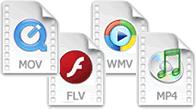HTML Multimedia
Multimedia on the web is sound, music, videos, movies, and animations.
What is Multimedia?
Multimedia comes in many different formats. It can be almost anything you can hear or see.
Examples: Images, music, sound, videos, records, films, animations, and more.
Web pages often contain multimedia elements of different types and formats.
In this chapter you will learn about the different multimedia formats.
Browser Support
The first web browsers had support for text only, limited to a single font in a single color.
Later came browsers with support for colors and fonts, and images!
Audio, video, and animation have been handled differently by the major browsers. Different formats have been supported, and some formats require extra helper programs (plug-ins) to work.
Hopefully this will become history. HTML5 multimedia promises an easier future for multimedia.
Multimedia Formats
Multimedia elements (like audio or video) are stored in media files.
The most common way to discover the type of a file, is to look at the file extension.
Multimedia files have formats and different extensions like: .swf, .wav, .mp3, .mp4, .mpg, .wmv, and .avi.
Common Video Formats
 |
MP4 is the new and upcoming format for internet video. MP4 is recommended by YouTube. MP4 is supported by Flash Players. MP4 is supported by HTML5. |
| Format | File | Description |
|---|---|---|
| MPEG | .mpg .mpeg |
MPEG. Developed by the Moving Pictures Expert Group. The first popular video format on the web. Used to be supported by all browsers, but it is not supported in HTML5 (See MP4). |
| AVI | .avi | AVI (Audio Video Interleave). Developed by Microsoft. Commonly used in video cameras and TV hardware. Plays well on Windows computers, but not in web browsers. |
| WMV | .wmv | WMV (Windows Media Video). Developed by Microsoft. Commonly used in video cameras and TV hardware. Plays well on Windows computers, but not in web browsers. |
| QuickTime | .mov | QuickTime. Developed by Apple. Commonly used in video cameras and TV hardware. Plays well on Apple computers, but not in web browsers. (See MP4) |
| RealVideo | .rm .ram |
RealVideo. Developed by Real Media to allow video streaming with low bandwidths. It is still used for online video and Internet TV, but does not play in web browsers. |
| Flash | .swf .flv |
Flash. Developed by Macromedia. Often requires an extra component (plug-in) to play in web browsers. |
| Ogg | .ogg | Theora Ogg. Developed by the Xiph.Org Foundation. Supported by HTML5. |
| WebM | .webm | WebM. Developed by the web giants, Mozilla, Opera, Adobe, and Google. Supported by HTML5. |
| MPEG-4 or MP4 |
.mp4 | MP4. Developed by the Moving Pictures Expert Group. Based on QuickTime. Commonly used in newer video cameras and TV hardware. Supported by all HTML5 browsers. Recommended by YouTube. |
Only MP4, WebM, and Ogg video are supported by the HTML5 standard.
Audio Formats
MP3 is the newest format for compressed recorded music. The term MP3 has become synonymous with digital music.
If your website is about recorded music, MP3 is the choice.
| Format | File | Description |
|---|---|---|
| MIDI | .mid .midi |
MIDI (Musical Instrument Digital Interface). Main format for all electronic music devices like synthesizers and PC sound cards. MIDI files do not contain sound, but digital notes that can be played by electronics. Plays well on all computers and music hardware, but not in web browsers. |
| RealAudio | .rm .ram |
RealAudio. Developed by Real Media to allow streaming of audio with low bandwidths. Does not play in web browsers. |
| WMA | .wma | WMA (Windows Media Audio). Developed by Microsoft. Commonly used in music players. Plays well on Windows computers, but not in web browsers. |
| AAC | .aac | AAC (Advanced Audio Coding). Developed by Apple as the default format for iTunes. Plays well on Apple computers, but not in web browsers. |
| WAV | .wav | WAV. Developed by IBM and Microsoft. Plays well on Windows, Macintosh, and Linux operating systems. Supported by HTML5. |
| Ogg | .ogg | Ogg. Developed by the Xiph.Org Foundation. Supported by HTML5. |
| MP3 | .mp3 | MP3 files are actually the sound part of MPEG files. MP3 is the most popular format for music players. Combines good compression (small files) with high quality. Supported by all browsers. |
| MP4 | .mp4 | MP4 is a video format, but can also be used for audio. MP4 video is the upcoming video format on the internet. This leads to automatic support for MP4 audio by all browsers. |
Only MP3, WAV, and Ogg audio are supported by the HTML5 standard.

